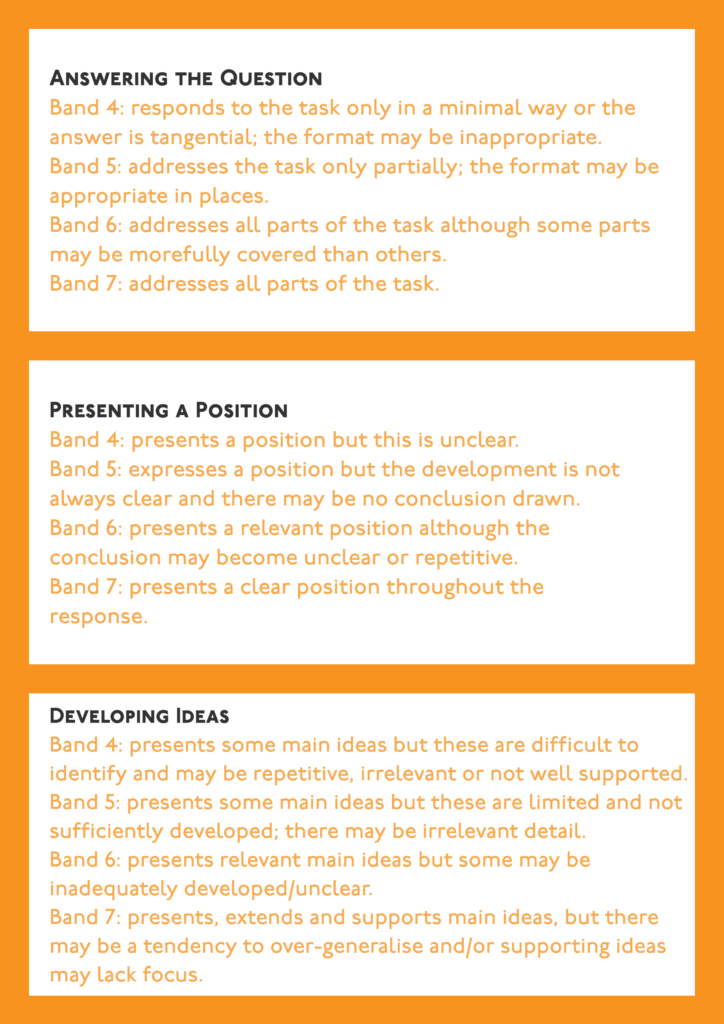What is task response?
Task response is about how well you answer the question. Your examiners are looking for three things for your task response score:
- Did you address the whole of the question?
- Did you present a clear position?
- Did you have enough well-developed ideas?
In this guide, we’ll explore these three aspects of task response, learn how to improve each of them and look at some examples of what you should be doing.

Answer the question
This section looks at how well you’ve answered the question. Taking a look at the criteria, we can see that knowing the question types can make a big difference but also that not knowing the question types is an easy way to lose points. To score higher in this area, take a look at our materials on question types in the IELTS writing exam. For each question type, you should know three things:
- What your thesis statement will be.
- What your first body paragraph will do.
- What your second body paragraph will do.
To give an example, ‘both sides and an opinion’ is one of the most IELTS question types. For this essay type, your thesis statement needs to give your opinion, your first body paragraph should give one side and your second body paragraph should give the other side. This means that if your essay question is
‘Some people believe that schools should move towards ebooks while others believe that they should continue to use paper books. Discuss both sides and give your opinion.’
You should :
- Give your opinion. For example, ‘This essay will argue that schools should transition to ebooks.’
- Write a body paragraph giving a reason for one side of the debate. This could be that ebooks require access to an electronic device which could be expensive for some students.
- Write a body paragraph giving a reason for the other side of the debate. You might argue that ebooks allow students to get access to a far wider range of books at instant speed.
While it might seem like a lot to remember three things for each question type, keep in mind that the IELTS questions are always very explicit about what they want you to do. Taking a careful look at the essay question should usually give you some clues about exactly what your examiner is looking for.
Present a position
This part of task response is all about having a clear argument. The key part to remember from the grading criteria is that the examiners are looking for this argument to be there “throughout the response”. This means that it’s not enough to just do this in the conclusion. You should give your position in the thesis statement portion of your introduction. Next, you should back up that position in your body paragraphs. Finally, you should restate your position in the conclusion. Coming back to our sample essay about schools using ebooks or paper books above, we could present a strong position by:
- Giving our opinion in the thesis statement. We’ll keep the one above: ‘This essay will argue that schools should transition to ebooks.’
- In the first body paragraph, have a strong topic sentence such as ‘One argument against ebooks is that they require access to an electronic device and some students may not be able to afford these.’
- In the second body paragraph, have another strong topic sentence. This could be ‘Conversely, ebooks allow students to cheaply and quickly access almost any book they want.’
- In the conclusion, we need to refer to both of the arguments we made and restate our opinion. This could look like this: “In conclusion, ebooks have advantages and disadvantages. One disadvantage is that they put a burden on students to buy electronic devices. However, they also allow students quick and cheap access to a wide range of books. Because I believe that access to education needs to be accessible to everyone, I believe that schools should continue to use paper books.
Develop your ideas
The final thing to pay attention to get a good score in task response is how well developed your ideas are. The main place where you can demonstrate this is in your body paragraphs. You should pick one specific idea for each of these body paragraphs and then develop it with explanations, arguments and examples. In our example above, one of our body paragraphs was about ebooks requiring expensive electronic devices. This is a good idea to develop because it’s quite narrow. If we had something like ‘There are several disadvantages to ebooks’ this would be much harder to explore in detail. For this paragraph we could write something like:
One argument against ebooks is that they require access to an electronic device and some students may not be able to afford these. Although ebooks are quite flexible and can be read on a range of devices like laptops, tablets or smartphones, all of these devices cost money. Even if a family can afford a laptop, they may be sharing one device between several family members. This means that if siblings all bring home ebooks from school, they might not all be able to access them at the same time. As a result, students from poorer families will struggle to read as much as students from richer families and educational inequality will increase.
In this example, I’ve given explanations, arguments and examples. Because this topic is nice and narrow, I’ve been able to give a solid amount of development for my ideas. By following this method, you can also have well-developed paragraphs that impress your examiners.